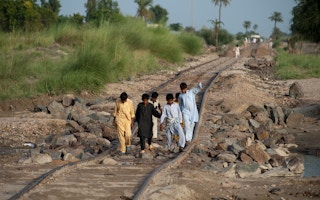Climate-fuelled disasters are damaging roads, railways, power networks and other vital infrastructure worldwide to the tune of hundreds of billions of dollars per year, said an alliance of more than 30 countries, urging better planning for more turbulent weather and rising seas as the planet warms.
Disasters are causing average losses of US$732 billion-US$845 billion each year to infrastructure and buildings, equal to 14 per cent of growth in global gross domestic product in 2022, estimated the Coalition for Disaster Resilient Infrastructure (CDRI).
Amit Prothi, director general of the Delhi-based CDRI, said the figures in its first report, issued on Wednesday, are “striking as they show the huge financial risk we carry today due to natural hazards and climate-related extreme events”.
The urban planning expert, who has worked in more than 15 countries including in North America, Asia and Europe, said it was important to get the numbers “in front of the decision-makers” to make the case for more robust infrastructure.
The CDRI, set up in 2019, supports countries to make their infrastructure more resilient to climate shocks and disasters.
It used risk models to calculate the disaster losses, which also include damage to social infrastructure such as schools and hospitals and the economic hit from service disruptions.
While one-third of the estimated losses are caused by geological hazards like earthquakes or tsunamis that are not climate-driven, climate-related hazards account for higher average annual losses across all regional geographies, it said.
Roads and railways, telecommunications, and power and energy together account for about 80 per cent of the total annual losses, said the report from the CDRI, which groups rich, emerging and low-income economies including Britain, the United States, Germany, Australia, Japan, the Maldives, Fiji and Ghana.
Prothi said new infrastructure should be built taking longer-term risks into account “so we don’t lose it over time”. The reports lists several examples of how that should be done.
China, for example, has developed so-called “sponge cities” by creating parks in and around cities that have water storage tunnels, rain gardens, wetlands and bioswales that aid drainage to prevent flooding and serve as water reserves for dry spells.
The report also highlights Malaysia’s use of multi-storey smart tunnels to regulate traffic and safeguard against flash floods, while a mangrove seawall in Guyana helps protect its low-lying areas against storm surges.
Poor nations hit hardest
About 30 per cent of the annual infrastructure losses due to extreme climate events and disasters - around US$280 billion - are borne by low and middle-income nations, putting a stress on their economies, the CDRI report said.
The highest share of losses is seen in South Asia at 0.42 per cent of GDP per year and Latin America and the Caribbean with 0.22 per cent.
If global warming accelerates fast, poorer nations will suffer “significant greater impact”, the report warned.
With high emissions that push temperatures up by 3-4 degrees Celsius, average annual losses could rise by 11 per cent in rich nations compared to 12-33 per cent in low and middle-income countries, including by nearly a quarter across South Asia and sub-Saharan Africa.
Making a case for better planning, the CDRI report noted that most of the new infrastructure required by 2050 for low and middle-income countries to develop cleanly has yet to be built - and the finance required remains concentrated in rich nations.
Annual infrastructure investment of about US$2.9 trillion will be required by 2050 in those nations to bridge the gap for achieving development goals while cutting climate-heating emissions to net zero, the report said.
Current levels of investment and climate finance represent “an order of magnitude lower”, reaching only about US$90 billion in 2021, it noted.
Many poorer nations are already distressed due to high debt levels incurred in recovering from the Covid pandemic and repairing damage to their infrastructure caused by disasters, leaving few able to make new investments, the report said.
There is an estimated US$106 trillion of untapped private capital worldwide - which would be more than enough to close the deficit, it added, noting that only 1.6 per cent of that amount is invested in infrastructure today.
And low and middle-income nations have attracted just a quarter of private infrastructure investment globally - mainly for non-renewable energy and transport.
Prothi said little money has flowed into preparing infrastructure for the impacts of climate change because it is not an area that is well understood by financial markets.
“(The) CDRI is working with countries to provide them with technical assistance to create a pipeline of adaptation projects that can become investable for the private sector,” he added.
This story was published with permission from Thomson Reuters Foundation, the charitable arm of Thomson Reuters, that covers humanitarian news, climate change, resilience, women’s rights, trafficking and property rights. Visit https://www.context.news/.

















